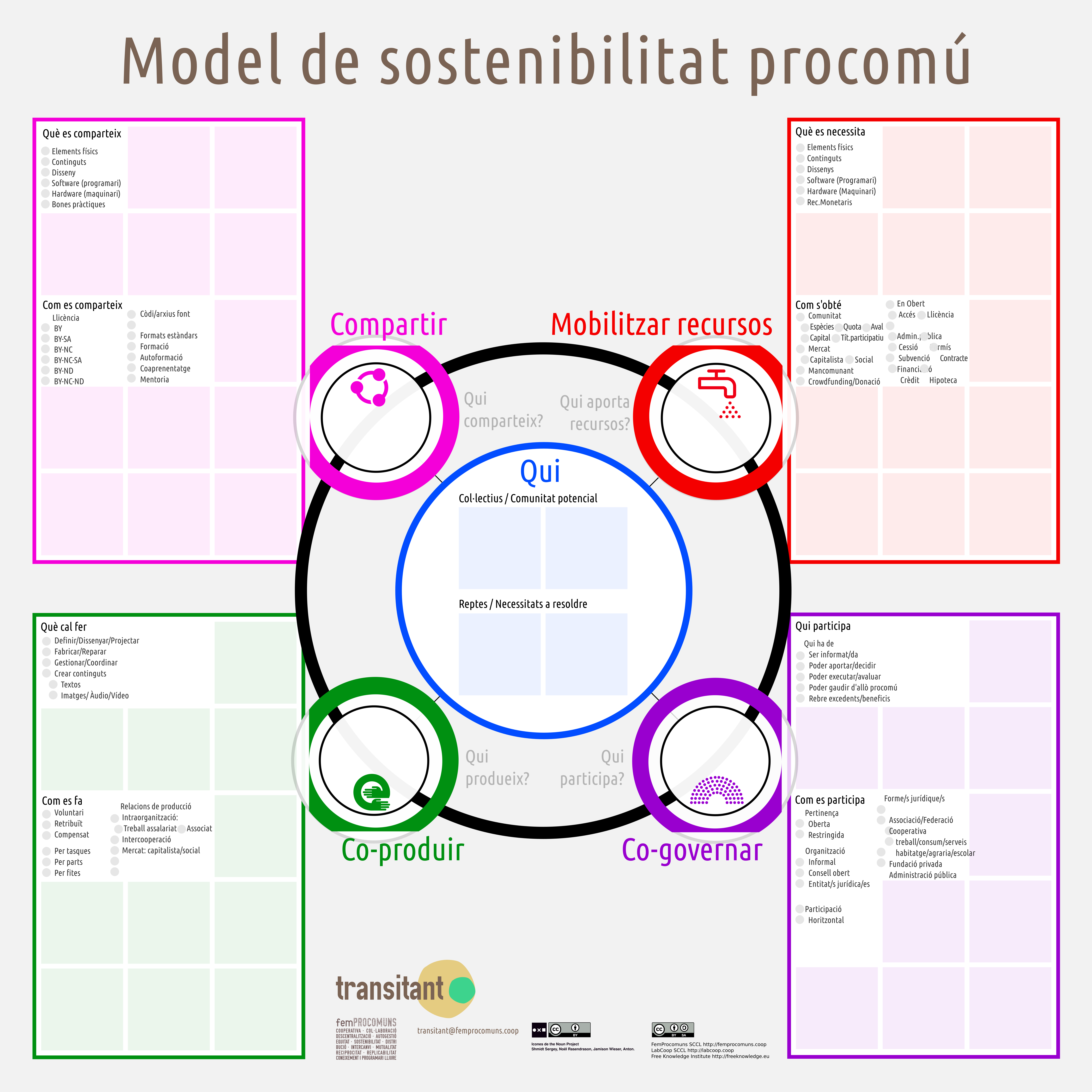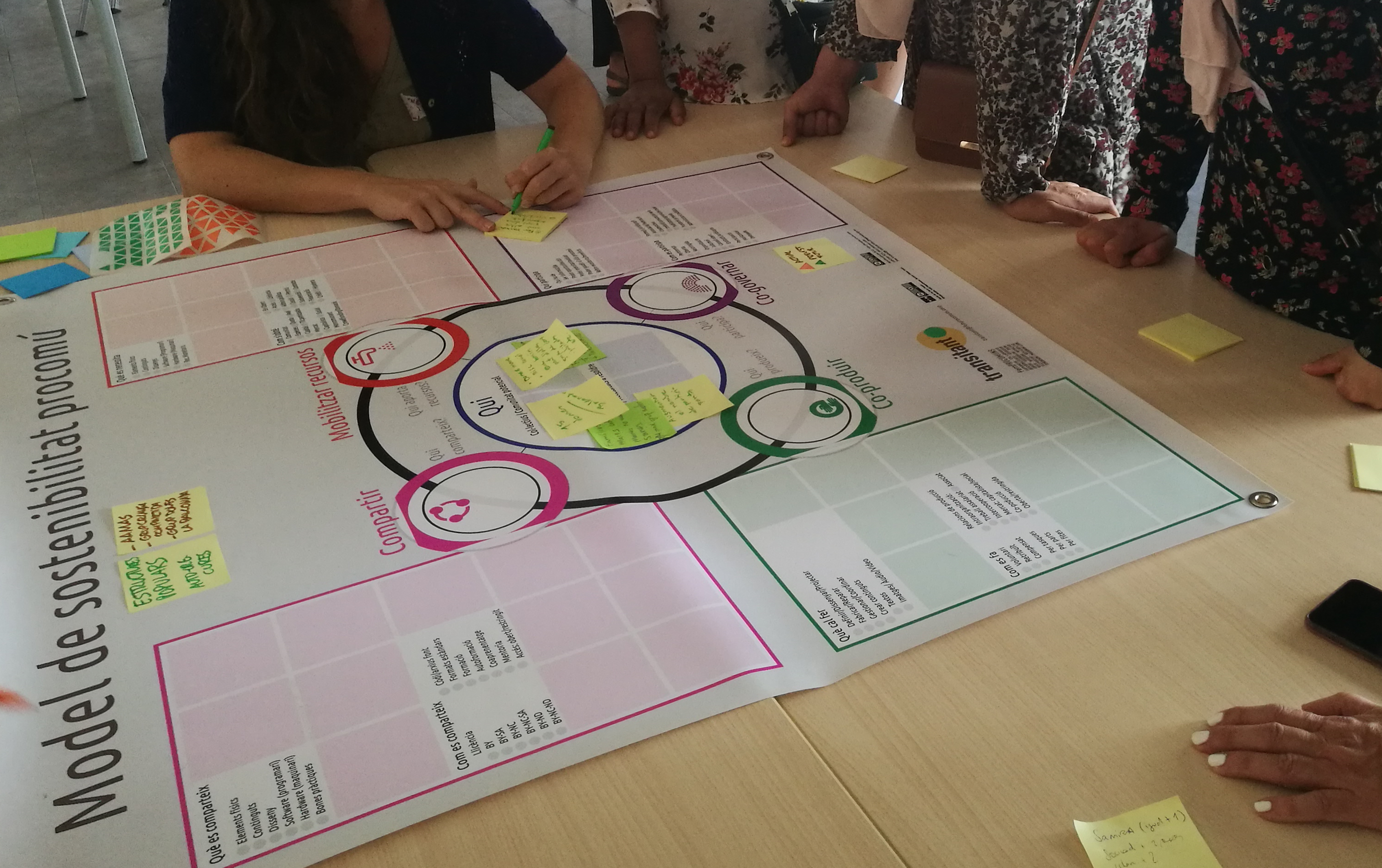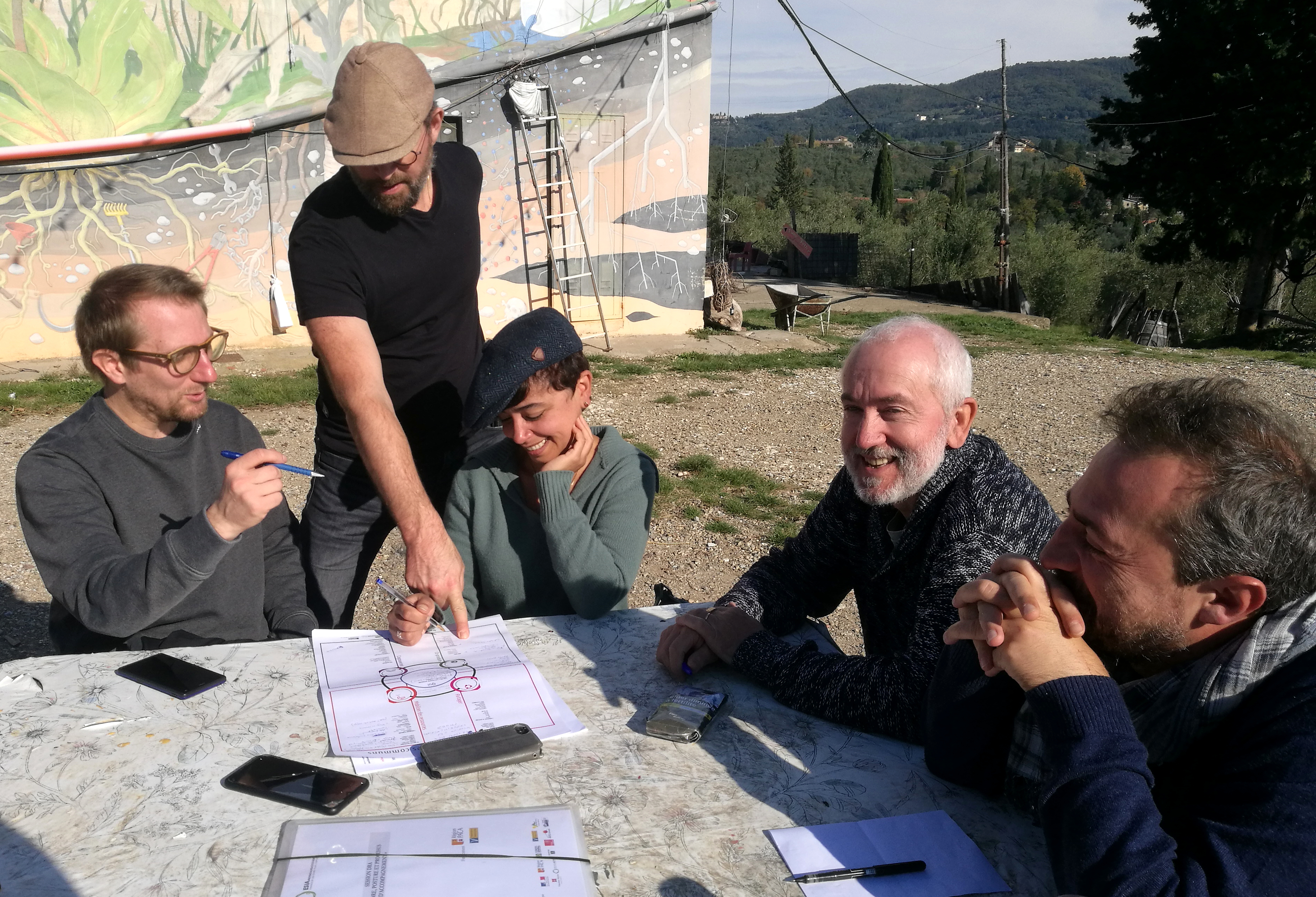This post is also available in: Español (Spanish) English
Llegiu l’article que vam publicar al Crític sobre el Model de Sostenibilitat del Procomú, un contramodel per treballar projectes que tenen la comunitat i la seva autoorganització al centre.

Podem trobar models que serveixin per enfortir el teixit comunitari davant les crisis del capitalisme i no haver-nos de servir de models de negoci que ens divideixen entre clients i proveïdors
L’agressivitat del capitalisme extractivista ha permeabilitzat tots els estrats de la vida, i ha donat lloc a l’emergència ecològica, la precarització laboral i l’amenaça d’un col·lapse sistèmic. Una de les vies per contrarestar aquest impacte és la creació i l’enfortiment d’estructures comunitàries des de l’autoorganització i l’autogestió, que permetin sostenir les persones i els ecosistemes amb cooperació i solidaritat.
Quan volem crear noves estructures comunitàries, ens trobem sistemàticament amb eines i metodologies de foment de l’emprenedoria, pensades des de la perspectiva del mercat capitalista, com el conegut Business Model Canvas [‘llenç de model de negoci’], que esquematitza el negoci en un sol full amb nou mòduls separats entre la part dels clients i la de l’empresa proveïdora. Són eines que promouen un model econòmic basat en la maximització del lucre, la competència entre projectes, la individualització del treball i el creixement del consum, estratègies que no ens serveixen, perquè són les que porten cap al col·lapse que justament volem evitar.
Hi ha altres eines conceptuals i metodològiques per treballar projectes en els quals al centre hi hagi la comunitat i la seva autoorganització, en lloc de la transacció i el lucre?
Quan volem crear noves estructures comunitàries, ens trobem eines pensades des del mercat capitalista
El model de sostenibilitat del procomú, un contramodel
A la cooperativa integral de consum i treball femProcomuns hem posat en pràctica el model de sostenibilitat del procomú. A Catalunya ho fem a través de programes d’impuls, formacions, tallers i sessions participatives, i el model i les seves metodologies s’han aplicat a desenes d’iniciatives existents per repensar-les, enfortir-les i aprofundir-ne la dimensió comunitària. També ha servit per facilitar i acompanyar la creació i l’impuls de nous projectes que busquen respondre a les necessitats i als reptes des de l’autoorganització.
El model parteix d’una concepció de l’economia com una manera de resoldre col·lectivament les necessitats de les persones (des del procomú, però també enfortint el mercat social solidari i les estructures públiques per garantir els drets fonamentals). Sense obviar que encara som en un entorn capitalista, el model trenca amb la visió binària que ens situa en l’un costat o l’altre d’una frontera entre rols (proveïdora/clienta, patró/treballador, voluntari/beneficiari) i busca identificar quin paper té cadascú en les diferents dimensions del projecte.
Per això es treballa amb cinc dimensions interconnectades entre si, que en la seva representació gràfica es poden explicar com a cinc pilars, amb un pilar central amb la comunitat i dos eixos encreuats entre el pilar de recursos i el de coproducció, d’una banda, i el de compartir i el de cogovernança, de l’altra. És una guia per fer una diagnosi del projecte, per poder avaluar quines dependències té del mercat capitalista i com anar-se’n alliberant per construir pràctiques més enfocades al procomú.

Procés de definició i elaboració del model, aportacions i usos
El model es va anar elaborant en paral·lel al seu ús al llarg de l’acompanyament de projectes, en programes, tallers i cursos, i molt especialment en el Curs de cooperativisme de plataforma i en la facilitació de cinc edicions del programa d’impuls La Comunificadora, ambdós en el context de Barcelona Activa (l’agència de promoció econòmica de l’Ajuntament de Barcelona) i va ser aplicat a diferents projectes que compartien entre si els seus processos. El punt de partida va ser un model d’Open Business Model Canvas que la fundació Free Knowledge Institute havia ideat per entendre projectes de referència del coneixement lliure.
Sòcies de femProcomuns i de la cooperativa LabCoop, amb aportacions clau d’altres persones i membres de projectes com el grup de recerca Dimmons, LliureTIC, Coopdevs o Som Mobilitat el van anar fent evolucionar per treballar els projectes acompanyats.
El model permet desenvolupar el potencial de les iniciatives segons els seus contextos i entorns
El resultat és el model i els materials visuals i el manual escrit que l’acompanyen, publicats amb llicències lliures i obertes, entès com un recurs de suport per mobilitzar un conjunt d’eines metodològiques, jurídiques i econòmiques, derivades de les ciències socials, dels processos de cocreació i de l’experiència acumulada en l’espai dels procomuns durant les darreres dècades. Permeten anar més enllà, analitzar el que existeix i desenvolupar el potencial de les iniciatives segons els seus contextos i entorns. Treballant conjuntament amb aquestes eines en un mateix territori o en un mateix àmbit, els actors poden desplegar noves maneres de cooperar i gestionar millor el propòsit dels seus projectes.

Transferència de coneixement
D’algun temps ençà femProcomuns ha començat un procés de transferència a Catalunya, amb Ecosistema Transitant, i fora de Catalunya amb el Grup de Treball Ecosistemes Procomuns, on hi participen amb Remix the Commons (França), Solidarius (Itàlia), B. A. Balex (França) i Projet Collectif (el Quebec).
Ecosistema Transitant
L’any 2022, amb finançament de la Generalitat de Catalunya, femProcomuns ha volgut posar a l’agenda catalana la mirada procomuna sobre diferents aspectes clau de l’economia i de la societat, a través d’Ecosistema Transitant. El projecte ha consistit a identificar entitats, organitzacions i institucions amb sensibilitats compartides, a través d’un procés de mapatge i d’enquestes, i coorganitzar vuit sessions temàtiques amb elles.

Hem vist l’energia i les comunitats energètiques locals, a l’Espai Tarragona Impulsa, a Tarragona; hem analitzat les metodologies del procomú, a l’Ateneu Coma Cros, de Salt; hem tractat del paper del voluntariat, a Can Fugarolas, de Mataró; hem parlat del territori, al Casal La Llavor, del Prat de Llobregat; hem examinat l’habitatge, al Núria Social, d’Olot; hem abordat les cures, a la Casa Flors Sirera, a Manresa; l’alimentació, a l’Espai Pomezia, a l’Hospitalet de Llobregat, i l’aigua, a Olesa de Montserrat.
Una cinquantena de projectes han estat analitzats amb els llenços del model del procomú en l’Ecosistema Transitant
D’entre els participants en destaquem un de cada sector: Solbrai, la comunitat energètica de Pinell de Brai; Can Fugarolas, el taller de reparacions socials i sostenibles a Mataró; Salvem l’Olla del Rei, plataforma per la defensa d’un espai natural clau per la diversitat de Castelldefels; Can Tonal, de Vallbona, projecte social i comunitari al Baix Montseny; Cuidem Lluçanès, una cooperativa de serveis d’atenció a les persones; Súper Coopera, el supermercat solidari i cooperatiu de Sabadell, i Comunitat Minera Olesana, la cooperativa de subministrament d’aigua d’Olesa.

Grup de Treball d’Ecosistemes Procomuns
Si la dimensió local és cabdal per als projectes comunitaris, l’enxarxament d’aquests amb iniciatives d’altres llocs del món és clau per fer possible un canvi sistèmic. Des de fa anys a femProcomuns hem mirat d’enxarxar-nos, buscar sinergies i maneres de fer en comú. Hem trobat aquests espais en la confluència procomuna del Fòrum Social Mundial de les Economies Transformadores (FSMET) el 2019, el CommonsCamp de Marsella del 2020, les trobades en línia d’Horitzons Comuns el 2021. Una confluència que ja era hereva de la feina feta en altres entorns, l’Assemblea Europea dels Comuns, les Jornades d’Economies Col·laboratives Procomuns, que es van organitzar des de Dimmons a Barcelona el 2016 i el 2017, i moltes altres iniciatives que seria impossible d’enumerar.
Ara, en el marc del Grup de Treball d’Ecosistemes Procomuns, s’han fet formacions internes sobre el model de sostenibilitat del procomú, s’ha començat a aplicar en projectes, i s’han fet tallers al barri de La Chapelle (París).
També s’ha fet una sessió Internacional en línia el 4 d’octubre passat, on es van presentar diversos projectes entorn de les metodologies del procomú i una trobada el 14 i el 15 de novembre, a Mondeggi, la comunitat de la Toscana (Itàlia) que vincula l’experiència rural d’una “granja procomuna” amb l’ecosistema urbà que l’envolta.
Models d’autogestió procomuns, encara ara, estan essent tancats o privatitzats
Aquest procés no ha acabat: models d’autogestió procomuns, encara ara, estan essent tancats o privatitzats a través de la mineria, de la desforestació agrícola o dels gegants tecnològics. Però el procomú, els recursos i els processos (la riquesa col·lectiva, de la natura, la infraestructura civil, les obres culturals, les tradicions, el coneixement…) són presents en el nostre entorn, i per preservar-los (des d’una perspectiva social i mediambiental), avui busquem (com ho van fer els nostres avantpassats) respostes en l’autoorganització de la gent, en l’associacionisme i en la revitalització i reinvenció del cooperativisme, com el que proposa el cooperativisme obert.

Canviar d’eines per canviar l’estat de les coses
Deia l’activista pels drets civils Audre Lorde que “les eines de l’amo no desmuntaran la casa de l’amo”. Aquesta afirmació, que és vàlida per a molts contextos (eines organitzatives, eines tecnològiques, eines econòmiques…), també ho és per a les eines metodològiques que fem servir per pensar i repensar els projectes transformadors. El moviment hacker ens ha ensenyat a apropiar-nos i subvertir les “eines de l’amo”. Però, per fer-ho, hem d’entendre bé com funcionen com a modeladores socioeconòmiques i capgirar-les per obtenir-ne altres models.
El model de sostenibilitat del procomú és una contribució per fer això possible. Un esforç per tenir eines alternatives i també per deixar-les obertes i transformar-les, si cal, a través de la prova-error o de la seva aplicació a diferents contextos. No és una eina única, sinó complementària d’altres eines que des de les pràctiques comunitàries transformadores s’estan proposant.

